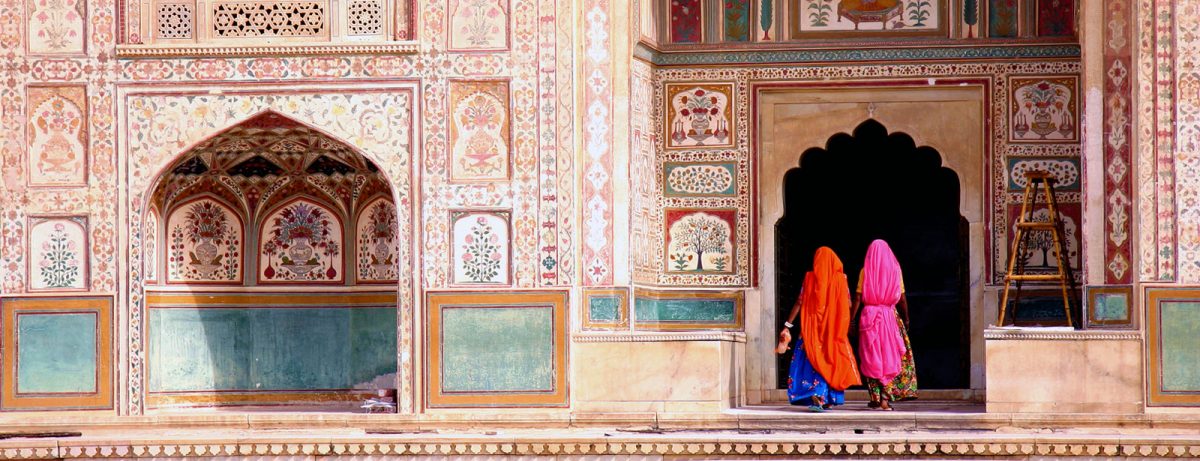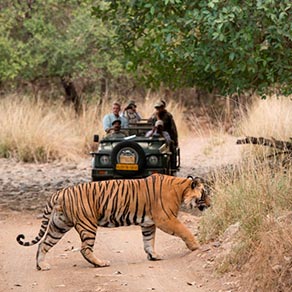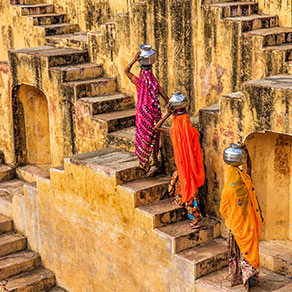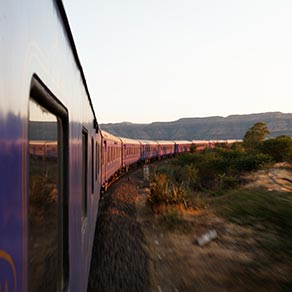Insider’s guide to the Golden Triangle
The Golden Triangle is the best-known route in India for foreign visitors. This “triangle” of destinations includes the historic city of Delhi, which boasts three UNESCO World Heritage sites; Agra, home of the Taj Mahal, the world’s most beautiful building; and Jaipur, the Pink City, capital of Rajasthan.
Delhi, Agra, and Jaipur are roughly equidistant apart, with the driving distance approximately 4 or 5 hours between them. You can also take a train between the three destinations.
Insider’s guide to India’s Golden Triangle

Delhi
Typically, Golden Triangle tours start in Delhi, as most international visitors land at Indira Gandhi International Airport in southwest Delhi. The capital of India, Delhi is a sprawling megalopolis of 18 million people (or more, depending on whether the National Capital Region is included), and one of the most historic cities on earth. Over the past 2,000 or so years, at least seven or eight major civilisations have built their capitals at Delhi – and each have left behind a beguiling trail of monuments.
Always crowded, Delhi also has extreme weather. It’s very hot from April to September, and surprisingly cold and foggy in December and January. It also has a “pollution season” that is at its worst in November. You have to take Delhi as it is! But that’s partly what makes it so fascinating.
A lot of tourists stay in central Delhi, however, try staying in South Delhi to enjoy the quieter side of life in the capital. In South Delhi, you can live more like a local, visiting cafes, parks, and local markets without the hassles that can spoil the more touristy areas. Walking tours are an ideal way to get to know Delhi. Don’t miss a food tour of Old Delhi, and you can also try a bicycle or rickshaw tour.

Agra
Next stop on the Golden Triangle itinerary is usually Agra, home to the Taj Mahal.
Almost every tourist who visits Agra goes to see the Taj Mahal, of course. It is a wonder of the world and worth the visit. The best tip for seeing the Taj Mahal is to go first thing in the morning, when it opens. It glistens in the morning sun, and the crowds are at a minimum. Be sure to carry as little as possible, just a bottle of water and your camera, as most items – even notebooks, pens, and tripods – are not allowed.
In spite of its renown as home of the Taj Mahal, Agra is not a beautiful or well-maintained city. However, it is known for a variety of local industries such as leather goods (shoes, bags, jackets, and belts), a translucent sweet called petha, marble work, and carpets. The marble table tops, jewellery boxes, vases and other items on sale in Agra are made with the same techniques as the Taj Mahal itself. In Agra, the carpets are woven using age-old techniques that go back to the time of Mughal Emperor Akbar. In Agra, some of the better manufacturers use vegetable dyes to make reproductions of famous Mughal designs. In other words, it’s a good place to dig in and shop local.
There are many other monuments in Agra to see including the Agra Fort and the abandoned city of Fatehpur Sikri, which is about an hour away. Also about an hour away from Agra are several rural locations that are well worth visiting to get away from the crowds and the pollution of the cities of the Golden Triangle.
Bateshwar is a small town on the Yamuna River lined with temples and ghats (steps). It is sometimes called mini Varanasi, but is far more peaceful. Across the river from the temples is a meadow, and trees filled with birds, so the only sounds you hear are bird songs and the many temple bells.
An ideal stop on your way from Agra to Jaipur, Bharatpur Bird Sanctuary and Keoladeo National Park is a peaceful oasis. You can stay in a resort or lodge right outside the park, and enjoy the peaceful atmosphere and the sight of many species of endemic and migratory birds.
Also on the way from Agra to Jaipur, Sawai Madhopur is home to Ranthambore National Park, one of the premier tiger reserves of India. There are dozens of wildlife lodges near Ranthambore, in every price range. Ranthambore is considered one of the best places to see tigers in the wild in India, and it is also a very scenic park, dotted with ancient ruins and lakes.

Jaipur
Last stop on the Golden Triangle tour, Jaipur was a planned city, designed on a grid pattern inspired by Hindu concepts. In fact, the entire city of Jaipur was certified as a World Heritage site by UNESCO in 2020. The Old City is referred to as the Pink City, as it was painted a pinkish colour for a visit by Prince Albert, husband of Queen Victoria, in 1876.
Jaipur is also a shopper’s paradise, as the city was designed as a commercial centre and is full of artisans. It’s famous for a variety of goods including gems, jewellery, block printing, leather shoes, and other arts and crafts. Prowling the many famous markets and bazaars of Jaipur, especially in the Pink City, is a favourite activity for most tourists.
Not to be missed are Johari Bazaar, Ramganj Bazaar, Tripolia Bazaar, and Bapu Bazaar. There is also a maze of alleys throughout the walled city that feature different goods – like the one completely devoted to lac bangles, one of the traditional crafts of Jaipur.
The top tourist attraction in Jaipur is Amber Fort, and it is certainly worth seeing as it is one of the largest and most well-preserved mediaeval forts in India, and a UNESCO site. Amber Fort is about 14 kilometres outside of Jaipur, one of the many attractions that skirt the city of Jaipur. There are several other forts, lots of great hiking trails, and the spectacular Kishan Bagh Sand Dunes Park. This park was rewilded by Pradip Krishen, a well-known Indian botanist who also created the amazing Rao Jodha Rock Park outside Mehrangarh Fort in Jodhpur. It’s a great way to experience the natural landscape of Rajasthan, slow down, and smell the flowers – though in this case, desert grasses – before heading back to Delhi.
YONDER SUGGESTIONS
Yonder is a specialist India tour operator, including tailor-made, luxury holidays to India which can include any of the must see places discussed in this article.
Previous holidays which we’ve booked include India’s Golden Triangle and Tigers tour, a culture, wildlife and backwaters tour in Kerala and the hidden India Rajasthan tour. These can be great inspiration for your own itineraries.
We can also arrange luxury holidays which explore all the different aspects of India such as our Incredible India tour.
All Yonder itineraries are crafted on a tailor-made, one-off basis, so you can be sure that your holiday will be as individual as you are.
The Golden Triangle is the best-known route in India for foreign visitors. This “triangle” of destinations includes the historic city of Delhi, which boasts three UNESCO World Heritage sites; Agra, home of the Taj Mahal, the world’s most beautiful building; and Jaipur, the Pink City, capital of Rajasthan.
Delhi, Agra, and Jaipur are roughly equidistant apart, with the driving distance approximately 4 or 5 hours between them. You can also take a train between the three destinations.
Insider’s guide to India’s Golden Triangle

Delhi
Typically, Golden Triangle tours start in Delhi, as most international visitors land at Indira Gandhi International Airport in southwest Delhi. The capital of India, Delhi is a sprawling megalopolis of 18 million people (or more, depending on whether the National Capital Region is included), and one of the most historic cities on earth. Over the past 2,000 or so years, at least seven or eight major civilisations have built their capitals at Delhi – and each have left behind a beguiling trail of monuments.
Always crowded, Delhi also has extreme weather. It’s very hot from April to September, and surprisingly cold and foggy in December and January. It also has a “pollution season” that is at its worst in November. You have to take Delhi as it is! But that’s partly what makes it so fascinating.
A lot of tourists stay in central Delhi, however, try staying in South Delhi to enjoy the quieter side of life in the capital. In South Delhi, you can live more like a local, visiting cafes, parks, and local markets without the hassles that can spoil the more touristy areas. Walking tours are an ideal way to get to know Delhi. Don’t miss a food tour of Old Delhi, and you can also try a bicycle or rickshaw tour.

Agra
Next stop on the Golden Triangle itinerary is usually Agra, home to the Taj Mahal.
Almost every tourist who visits Agra goes to see the Taj Mahal, of course. It is a wonder of the world and worth the visit. The best tip for seeing the Taj Mahal is to go first thing in the morning, when it opens. It glistens in the morning sun, and the crowds are at a minimum. Be sure to carry as little as possible, just a bottle of water and your camera, as most items – even notebooks, pens, and tripods – are not allowed.
In spite of its renown as home of the Taj Mahal, Agra is not a beautiful or well-maintained city. However, it is known for a variety of local industries such as leather goods (shoes, bags, jackets, and belts), a translucent sweet called petha, marble work, and carpets. The marble table tops, jewellery boxes, vases and other items on sale in Agra are made with the same techniques as the Taj Mahal itself. In Agra, the carpets are woven using age-old techniques that go back to the time of Mughal Emperor Akbar. In Agra, some of the better manufacturers use vegetable dyes to make reproductions of famous Mughal designs. In other words, it’s a good place to dig in and shop local.
There are many other monuments in Agra to see including the Agra Fort and the abandoned city of Fatehpur Sikri, which is about an hour away. Also about an hour away from Agra are several rural locations that are well worth visiting to get away from the crowds and the pollution of the cities of the Golden Triangle.
Bateshwar is a small town on the Yamuna River lined with temples and ghats (steps). It is sometimes called mini Varanasi, but is far more peaceful. Across the river from the temples is a meadow, and trees filled with birds, so the only sounds you hear are bird songs and the many temple bells.
An ideal stop on your way from Agra to Jaipur, Bharatpur Bird Sanctuary and Keoladeo National Park is a peaceful oasis. You can stay in a resort or lodge right outside the park, and enjoy the peaceful atmosphere and the sight of many species of endemic and migratory birds.
Also on the way from Agra to Jaipur, Sawai Madhopur is home to Ranthambore National Park, one of the premier tiger reserves of India. There are dozens of wildlife lodges near Ranthambore, in every price range. Ranthambore is considered one of the best places to see tigers in the wild in India, and it is also a very scenic park, dotted with ancient ruins and lakes.

Jaipur
Last stop on the Golden Triangle tour, Jaipur was a planned city, designed on a grid pattern inspired by Hindu concepts. In fact, the entire city of Jaipur was certified as a World Heritage site by UNESCO in 2020. The Old City is referred to as the Pink City, as it was painted a pinkish colour for a visit by Prince Albert, husband of Queen Victoria, in 1876.
Jaipur is also a shopper’s paradise, as the city was designed as a commercial centre and is full of artisans. It’s famous for a variety of goods including gems, jewellery, block printing, leather shoes, and other arts and crafts. Prowling the many famous markets and bazaars of Jaipur, especially in the Pink City, is a favourite activity for most tourists.
Not to be missed are Johari Bazaar, Ramganj Bazaar, Tripolia Bazaar, and Bapu Bazaar. There is also a maze of alleys throughout the walled city that feature different goods – like the one completely devoted to lac bangles, one of the traditional crafts of Jaipur.
The top tourist attraction in Jaipur is Amber Fort, and it is certainly worth seeing as it is one of the largest and most well-preserved mediaeval forts in India, and a UNESCO site. Amber Fort is about 14 kilometres outside of Jaipur, one of the many attractions that skirt the city of Jaipur. There are several other forts, lots of great hiking trails, and the spectacular Kishan Bagh Sand Dunes Park. This park was rewilded by Pradip Krishen, a well-known Indian botanist who also created the amazing Rao Jodha Rock Park outside Mehrangarh Fort in Jodhpur. It’s a great way to experience the natural landscape of Rajasthan, slow down, and smell the flowers – though in this case, desert grasses – before heading back to Delhi.
YONDER SUGGESTIONS
Yonder is a specialist India tour operator, including tailor-made, luxury holidays to India which can include any of the must see places discussed in this article.
Previous holidays which we’ve booked include India’s Golden Triangle and Tigers tour, a culture, wildlife and backwaters tour in Kerala and the hidden India Rajasthan tour. These can be great inspiration for your own itineraries.
We can also arrange luxury holidays which explore all the different aspects of India such as our Incredible India tour.
All Yonder itineraries are crafted on a tailor-made, one-off basis, so you can be sure that your holiday will be as individual as you are.

 USD
USD



